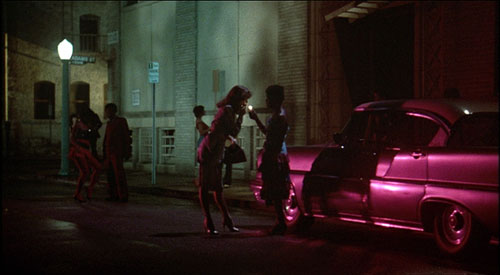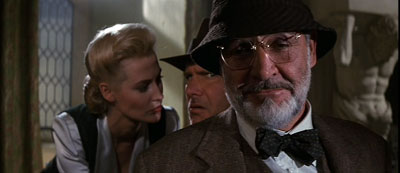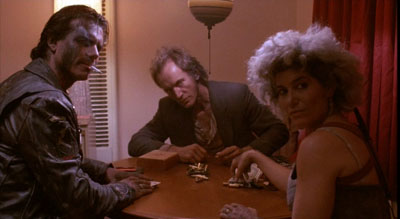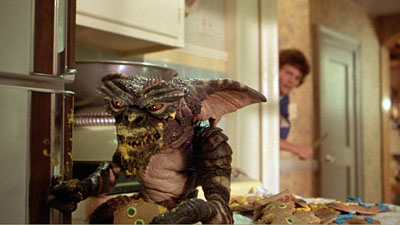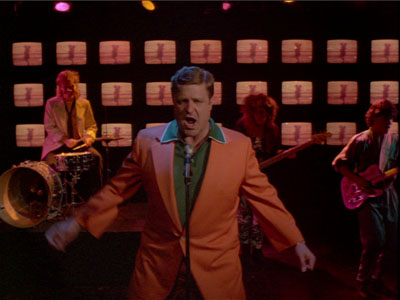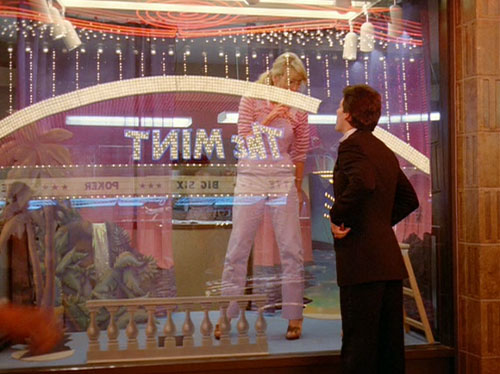It’s the 80s, stupid
Thursday | November 20, 2008 open printable version
open printable version
Choose Me.
DB here:
In an earlier post, I proposed that film historians can’t safely assume that decades mark off meaningful periods. Yet I can’t help succumbing to the temptation myself. It happens every time I hear about how the 1970s were the last great decade in American film.
We’re often told that back then, countercultural forces gave us movies of restless auteur ambition like Five Easy Pieces and Nashville and Mean Streets and Shampoo. Meanwhile, The Godfather, Jaws, American Graffiti, and even Star Wars not only rejuvenated the studio system but also reflected something of their directors’ temperaments, providing Hollywood with an enduring new mythology. So far, so plausible.
Then, the story goes, came the age of the blockbuster. Thereafter, moviemaking was simply selling out, winning the weekend, building franchises, and catering to disposable teenage income. Like big hair and padded shoulders and Wham!, the films of the 1980s are apparently something to be ashamed of.
The glorious burnout
This judgment is spelled out most fully in Peter Biskind’s Easy Riders and Raging Bulls, a celebration of and postmortem on the Movie Brats era of the 1960s-1970s. Biskind doesn’t try to make a critical case for the films of the period; he assumes that everyone counts these movies as edgy masterpieces. He’s more interested in the sensational lifestyle of the filmmakers. Filling his pages with gossip about alcohol, cocaine, backbiting, squabbles, and the horizontal mambo, he could hardly deny that his favorite directors were somewhat self-destructive. He justifies their escapades by treating them as driven artists fighting a corrupt system—mavericks, in fact. (Yes, he uses the word.) This idealization occasionally leads to mawkishness that Biskind would castigate if he saw it on the screen:
Hal Ashby did die just after Christmas, on a raw, rainy Tuesday. . . .The papers said it was liver and colon cancer, but it could just as well have been a broken heart. (1)
Forgiving the flaws of these all-too-human directors, Biskind spares no sympathy for the producers who focused on the bottom line. With rising budgets and distribution costs, the studios’ cynical leaders chose to play safe with megapictures that purveyed “smarmy, feel-good pap.” (2)
It’s a good, simple story, and the problem is the simplicity. The top-grossing movies of the 1970s include Love Story, Fiddler on the Roof, The Sting, The Towering Inferno, Rocky, Grease, Smoky and the Bandit, and Star Trek: The Motion Picture. These aren’t exactly testaments to personal expression. The megapicture mentality we associate with the 1980s was already present in some of these, as well as in The Poseidon Adventure, Earthquake, and Superman. The four-quadrant movie was taking shape well before Heaven’s Gate brought auteur ambitions crashing to earth.
Further, not every 1980s movie aimed to be a blockbuster. I tried to argue in The Way Hollywood Tells It that just as in the classic studio era, we have to look for creativity beyond the titles that dominate the best-10 and top-grosser list. In addition, there are always filmmakers whose sensibilities naturally match the demands of big-budget projects: David Lean and Anthony Mann managed it in the 1960s, Spielberg and Lucas in the 1970s. In the 1980s several directors were able to make strong, original megapictures.
So you can make a good case that the 1980s gave America a burst of first-rate films and remarkable new talent. At all levels, from ambitious prestige items to dazzling genre pictures, the decade is nothing to be sneezed at. The maw of home video had to be fed, so the demand was for product of all sorts. Videotape rental expanded specialty niches and cult markets. Filmmakers could finance projects through video and foreign presales, and investors took chances at many levels. The era saw a revival of ambitious independent films, which played alongside program pictures, Oscar bait, and summer blockbusters. Romantic comedy, action movies, and science fiction enjoyed a strong run. And many of the people we still consider genuine movie stars—Tom Hanks, Julia Roberts, Glenn Close, Harrison Ford, Mel Gibson, and Tom Cruise—are ineluctably creatures of the 80’s.
My defense doesn’t spring from generational bias. I don’t have the excuse of adolescent nostalgia that makes Tom Shone write:
What a grand piece of historical luck it was to be in your early teens when Raiders of the Lost Ark came out—when Spielberg and Lucas were in their prime and the very act of going to the movies seemed to come with its own brassily rousing John Williams score. Later on, we would learn to cuss and curse the infantilization of the American film industry, just like everyone else, but back then we were too busy infantilizing it to notice. (2)
So here are some assorted, more or less objective reasons to consider this decade as making a remarkable contribution to U. S. film history.
New talents, old genres
Near Dark.
Put aside two highly influential 1980s films, E. T.—The Extraterrestrial and Raiders of the Lost Ark, since Biskind would consider them feel-good pap. Put aside Raging Bull, which he grants canonical status as the capstone masterwork of the 1970s generation. Even granting all this, most major 1970s directors didn’t vanish in the megapicture decade.
Scorsese’s underrated King of Comedy was a portrait of a social type, the obstinate, delusional nerd; we all knew one, but we hadn’t seen him on the screen before. Altman moved from Popeye, a sort of anti-musical and anti-comic-book movie, to intimate theatre pieces like Streamers and Secret Honor and Fool for Love.
From Jonathan Demme we had Melvin and Howard and Something Wild; from Clint Eastwood, Pale Rider and Bird; from Paul Schrader, American Gigolo, Cat People, Mishima, and the Bressonian Patty Hearst. Coppola, supposedly a marked man after Apocalypse Now, gave us another anti-musical (One from the Heart) and a robust biopic (Tucker: The Man and His Dream). De Palma outraged his audience with Dressed to Kill, Blow Out, and Scarface. John Carpenter’s B-movie sensibility was given full throttle in Escape from New York, The Thing, and Big Trouble in Little China. And arguably David Cronenberg hit his stride with Scanners, Videodrome, The Dead Zone, The Fly, and Dead Ringers. Maybe we should just call the 80’s the Cronenberg Years.
Veteran directors also got in their licks. Sidney Lumet had a remarkable run; if you bet on Serpico, I see you The Verdict and raise you Prince of the City. Sergio Leone offered Once Upon a Time in America, a film that looks more ambitious on each viewing. John Huston checked in with Prizzi’s Honor and The Dead, Sam Fuller with The Big Red One.
Biskind castigates the 1980s for parvenu producers like Don Simpson and Michael Eisner, but he doesn’t mention all the new directors who emerged. Some allied themselves with independent companies or mini-majors, others worked through the studios, but in any case it’s strange to overlook Michael Mann, Oliver Stone, Tim Burton, the Coens, Spike Lee, Robert Zemeckis, James Cameron, George Miller, Barry Levinson, John Sayles, Gus Van Sant, Jim Jarmusch, Katherine Bigelow, David Mamet, Steven Soderbergh, et al. Just cherry-picking their films yields up Thief, Manhunter, Salvador, Platoon, Wall Street, Born on the Fourth of July, Pee-Wee’s Big Adventure, Beetlejuice, Batman, Blood Simple, Raising Arizona, She’s Gotta Have It, School Daze, Do The Right Thing, Used Cars, Diner, Tin Men, The Abyss, Return of the Secaucus Seven, Matewan, Mala Noche, Drugstore Cowboy, Stranger than Paradise, Down by Law, Mystery Train, Near Dark, House of Games, Things Change, sex, lies and videotape. Not many dribs of feel-good pap in this bunch.
There was a lot of bloated Oscar bait, I grant you. Is anybody, anywhere on the globe watching Gandhi or Chariots of Fire or Driving Miss Daisy at the moment? But we had Amadeus, an intelligent biopic, as well as Tender Mercies and Coal Miner’s Daughter and Rain Man.
The 1980s kept genres firmly at the center of Hollywood. Instead of working against genre conventions, as many Movie Brats had done (not all; remember Bogdanovich), many of the most talented Eighties directors found ways to do what they wanted in and through genres. In this sense, they were more like Hawks and Ford and other classical filmmakers. The “personal” mainstream film wasn’t a contradiction in terms.
Take science fiction. Blade Runner, which became as influential as Metropolis and 2001, pushed to an extreme the premise of Alien: The future will be rusty, drippy, and stygian. Blade Runner also expanded teenage vocabularies by at least one word (can you say dystopian?). Handed another cult science-fiction story, David Lynch turned Dune into a pageant of hallucinatory grotesques. Voices float unbidden in the air, and boils never looked so glistening. Today, these overstuffed genre pieces repay viewing more than Out of Africa does.
Granted, the 80s gave us plenty of earnest clunkers in the drama department, perhaps most notably The Color Purple. But we also have Body Heat, Never Cry Wolf, Fatal Attraction, Witness, Kiss of the Spider Woman, The Accused, Terms of Endearment, The Right Stuff, Field of Dreams, River’s Edge, Places in the Heart, The Big Chill, and other sturdy efforts.
If you admire Ishtar, then add it to this list. Ditto the parboiled stylings of Alan Parker: Pink Floyd The Wall, Birdy, Angel Heart, and Mississippi Burning. And if you grew up on John Hughes movies, there’s no more to be said by me. You probably still love Sixteen Candles, The Breakfast Club, and the rest. Okay, maybe we should consider it the Hughes decade.
Laughs and bullets
Fantasy comedy flourished in the period, from a masterpiece of dark humor like Beetlejuice to amiable fare like Ghostbusters, Big, Splash, and All of Me. Add to this list Gremlins, sort of the down-and-dirty E. T.; I dare you to watch this or the 1990 sequel without laughing. Farce was also on the agenda, with the output of Mel Brooks (Spaceballs) and the Zucker-Abrams team (Airplane! Top Secret!), and one-offs like A Fish Called Wanda. Saturday Night Live continued to breed new stars. Bill Murray, today an axiom of the independent cinema, made his debut in the period. And after The Adventures of Pluto Nash (2002) and Meet Dave (2008), it’s heartening to remember Eddie Murphy’s appeal in 48 HRS, Beverly Hills Cop, Trading Places, and Coming to America.
On the romantic comedy front, we had Victor/ Victoria, Mystic Pizza, Desperately Seeking Susan, Broadcast News, Moonstruck, Bull Durham, and one of the supreme achievements in the genre, Tootsie. I never met anybody who didn’t like Tootsie.
Speaking of romantic comedy, every era has its favorite perky blonde. Long ago it was Doris Day; today it’s Reese Witherspoon. In between came Goldie Hawn, who gave us Private Benjamin and, mixing it up with Chevy Chase, two trim comedies Foul Play (okay, 1978) and my own favorite, Seems Like Old Times, a frothy revival of the screwball tradition. Her mantle was picked up by Meg Ryan in When Harry Met Sally, and she continued to deliver pert-and-lovable through the 1990s.
Movies centering on kids, like WarGames and The Karate Kid and Stand by Me, proved unexpectedly enjoyable to grownups too. Back to the Future was an intricate Oedipal fable, coarsened but also complicated in the second installment and sweetened in the third. Coppola’s flirtation with teenage art movies gave us The Outsiders and Rumble Fish. Fame is probably a part of every Gen-Xer’s childhood too, as are other musicals like Flashdance, Dirty Dancing, Hairspray, and the 1989 resurrection of Disney animation, The Little Mermaid.
With the new attractiveness of the global market, the demands of home video, and increasingly sophisticated special effects, the 1980s brought the really violent action movie into its own. I’m not ready to defend Rambo and its clones, not even the indifferently directed Lethal Weapon. But I will stick up for Fort Apache—The Bronx, The Terminator, Robocop, Aliens, Predator, and The Untouchables, the last of which has given us many lines appropriate to President-elect Obama’s Chicago-based campaign. (“Brings a knife to a gunfight.” “They send one of yours to the hospital, you send one of theirs to the morgue.”) Road Warrior probably counts as an import, but we ought to treat Mad Max Beyond Thunderdome as a Hollywood release. This sequel transposes the earlier film’s grimly amusing chases and stunts into full-out slapstick, while giving us one of the most touching finales of any film of its day.
I save for last the obligatory mention of Die Hard, the Jaws of the 1980s: a perfectly engineered entertainment.
Middlebrow, semi-highbrow
I don’t automatically despise middlebrow culture (a subject, I hope, for a future blog). But many cinephiles do, so I’m probably in the minority in my esteem for another prototypical 80s director, Ron Howard. Like Zemeckis, he started his climb with a something a little naughty, the mortuary comedy Night Shift. Thereafter he tried to update Hollywood genres in ingeniously middlebrow fashion, from Cocoon and Gung Ho to Parenthood, probably his best film of the decade.
Hollywood films have long blended art-cinema experimentation and genre conventions; it’s what a lot of people found exciting about The Conversation and The Godfather Part II and the seventies work of Altman. That sort of blending continued in the 1980s. The most obvious examples came from David Lynch, with The Elephant Man (surreal visions plus disfigured hero) and Blue Velvet (the Hardy Boys meet sadomasochism). Another merger of art movie and genre movie was The Stunt Man, a three-card-monte affair about moviemaking. Want a postmodern musical? David Byrne’s True Stories treated avant-garde art as of a piece with down-home kitsch. The music track is infectious, with the lip-sync sequence on “Wild, Wild Life” capturing the sense that everyone can be famous for, well, not fifteen minutes but about ten seconds.
I’m venturing onto disputed terrain here, but I vote for Alan Rudolph’s Choose Me as an intelligent blend of Euroart neuroticism and off-kilter romantic comedy. The first shot, a long take craning down the side of a bar sign and along a street filled with hustlers sometimes dancing and sometimes not, accompanied by Teddy Pendergrass’s music, remains a tingling moment of bravado. The interruptive flashbacks (or are they visions?) and some tricky pan shots play daringly with character motivations. I also admire Trouble in Mind and The Moderns, but I realize that making a case for them would probably be pushing my luck.
When was the last time Woody Allen made a really good movie? Hard to say, but recall three 1980s titles: Hannah and Her Sisters, Zelig, and Crimes and Misdemeanors. They show that Allen could take chances with adventurous narrative strategies, while mixing in mordant dialogue, social satire, surprisingly bitter comedy, and earned pathos. Consider Radio Days the cherry on top.
There are plenty of other worthwhile items: My Favorite Year, The Dream Team, Valley Girl, Adventures in Babysitting, Excalibur, Earth Girls Are Easy, The Abyss, This Is Spinal Tap, D. C. Cab, The Princess Bride, Total Recall, Day of the Dead, Monkey Shines, Streets of Fire, Housekeeping, Purple Rain, Koyaanisqatsi, The Thin Blue Line, and on and on. Few are perfect, but most offer genuine pleasures, and some are as imaginative and bold as the canonized films of the 1970s, albeit in different registers.
Not every film on my list will convince everybody, but I think there are enough solid achievements to show that the blockbuster era didn’t suffocate creative filmmaking in the U.S. In some cases it enhanced it.
Come to think of it, the American cinema always renews itself. Take the 90s. There’s My Cousin Vinny and . . . .
(1) Biskind, Easy Riders and Raging Bulls: How the Sex-Drugs-and-Rock’n’Roll Generation Saved Hollywood (New York: Simon and Schuster, 1998), 438.
(2) Biskind, Easy Riders, 404.
(3) Tom Shone, Blockbuster: How Hollywood Learned to Stop Worrying and Love the Summer (New York: Free Press, 2004), 11. Shone’s book is the best antidote I’ve found to the overreaching attacks on 1980s cinema. For a dauntingly comprehensive filmography, see Robert A. Nowlan and Gwendolyn Wright Nowlan, The Films of the Eighties (Jefferson, NC: McFarland, 1991).
One from the Heart.












